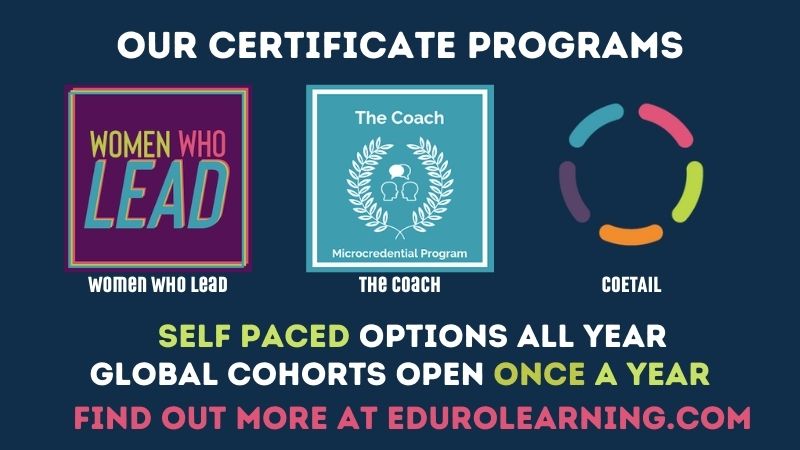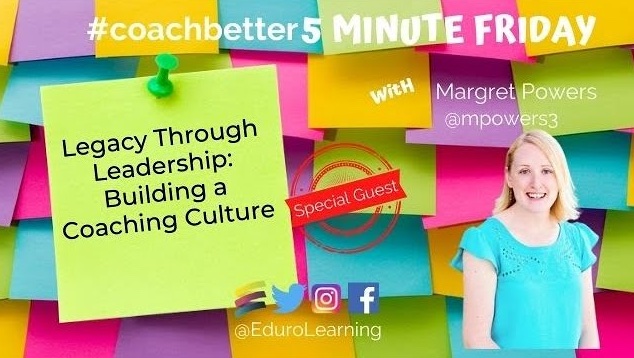We are always looking for strategic ways to build a coaching culture in our school communities. On this season of the #coachbetter podcast, I spoke with Margaret Powers, Director of STEAM Innovation at the Agnes Irwin school outside of Philadelphia. In that episode Margaret shared the background and structure of their legacy through a leadership program to build capacity for instructional coaching in her school.
Margaret had so much to share that after our conversation for coach better, I specifically asked her to record an episode for our 5 Min Fri YouTube series, to getting into the details of how the legacy through leadership program was built. So that if you are looking for a structure to build capacity for instructional coaching among the teachers in your school, you can get that foundation here, from this guest post & video from Margaret.
Program Vision & Purpose
The Legacy Through Leadership program focuses on scaling innovation throughout the school and also distributing leadership. The goal of the program in part is to create teacher leaders, and we do that with instructional coaching. The program is focused on looking at a new way for professional development to work in our school. In addition to kind of one-off PD days and pop-ups, we wanted to create a program that would support our strategic plan of energizing our educators, and also helping them to figure out ways to ignite students’ curiosity and creativity. It was important to us that we design a program that would be sustainable, that would energize educators, educators to not only participate, but to finish the program feeling reinspired to be an educator, to continue teaching, to collaborate and share with their colleagues and to be a leader in the school.
3 Main Areas of Focus
We designed the program to have three main areas of focus:
1:: Teacher Research and Pedagogy
Empowering teachers to dig into some research around, best practices for girls working on the girl’s school and thinking out their pedagogy, looking back on their initial teaching philosophy, thinking about whether or not that’s changed. If they want to just think about what practices they’ve been hearing about maybe a little past few years that they want to try, but we just didn’t have the time or the energy to do so. They would have support through this program to do that.
2: Mindset
Helping teachers to develop mindsets that would support this kind of innovative teaching and openness, a growth mindset, a mindset focused on community and kind of collaborating with your colleagues and also being a leader in the school. but also really focuses on teacher wellness. We talk about the whole child a lot, and we wanted to design a program that would look at the whole teacher and support our educators and taking care of themselves.
3:: Personalized Learning
We want our students to have opportunities for personalized learning, and we realized that that needed to start with our teachers. The program really allows participants to decide what components are going to be part of their professional growth pathway in the program. There were two levels of participation the very first year, back in 2017, we had applications for innovation fellows to apply, and those fellows who would then get training in instructional coaching, and then they would, over the next few years, work as what we call “thinking partners” with future participants of the program. Those participants became what we call “teacher leaders” and both teacher leaders and innovation fellows would get to have a mentor from my team or innovation directors, and they would get to create their own professional growth pathways part of this program.
Program Foundations
Our coaching used Jim Knight’s approach as our foundation. We all read the Impact Cycle book together. We use his seven part principles as the foundation for how thinking partners work together. It’s really looking at reciprocity, give and take going into each other’s classrooms (we do use swivel cameras when schedules don’t allow for that), but sitting down together basically, and talking about your practice. Finding a way to capture current reality, whether that is going into the classroom and observing or watching a video together, helping the teacher leader to identify their own goal. Then working through that with them to provide resources and provocations or prompts that helps them to achieve that goal slowly over time with support with this thinking partner who can think out loud with them about what’s working and what might not be going as crazy like in a classroom, reflecting on that together.
Coaching Through Innovation Fellows
The coaching component obviously is a really critical piece of the program. Each year our teacher leaders, work with an innovation fellow who becomes their thinking partner and they’ll meet, every two or so weeks and go through an impact cycle, at least once, usually maybe twice in the school year, aside from that coaching arm of the program, the other arm is this
The Professional Growth Pathways
There are six components of that Professional Growth Pathway that everyone has, but how you kind of fulfill that pathway and what it looks like is different for each participant. You have to, do a certain number of each of these components, what you choose, what they are. For example, in self exploration, we might be using Stanford’s good time journal to figure out, the best ways of organizing your day and energizing yourself. You might be doing it via strengths assessment. This is the area of your pathway, where you can really focus on wellness and balance. In addition to all the other ways you’re growing as a professional, you can see some examples of things you might do for the learning components or teaching components weekend, one teachers to experience what it’s like to be a learner.
Shared Language & Workshop Experiences
A big part of developing the Professional Growth Pathways was attending these six workshops. This allowed us to establish shared language and experiences that everyone engages with. Workshops on things like differentiated instruction, maker, education, design thinking, things that were, are really important to us as a school in terms of core content and professional development. It’s been really exciting because it means that everyone now who’s gone through the program has had the same workshops. They have this shared language and experience that they can talk to one another about.
Another important component of the pathway is sharing. The participants are required to share their learning, whether it’s at an all school meeting, through blog posts, etc. This allows the program to kind of spread out even to participants who aren’t in it at the moment. It helps the inspiration to grow and leads to this domino effect. When you hear a colleague who you weren’t maybe expecting to love the program or to try this new thing in their classroom, and they’re doing it, and they’re really excited about it, it’s led other participants to try it the following year. That organic growth has been really great for us.
Personalized Professional Development
The three key elements of the program are:
- The Professional Growth Pathway.
- Pathway Workshops
- Coaching through Innovation Fellows
All of these tie together to provide personalized professional development all year long. You have some time during the school day that you get to meet with your thinking partner your IT team, your innovation director and your mentor. You get a lot of extra support for an entire year to meet your own professional goals, to grow as an educator and hopefully as a person, as well (looking again at that whole educator model and helping to establish balance and mindfulness practices like that).
It’s been really powerful for us at the school and exciting to see it really has energized our educators. It’s made a big difference in some of the classrooms from our teacher leaders, as they’ve tried on new practices and made changes and tweaks based on reflection and dialogue with their thinking partner. And it’s definitely a ground up to grow approach that I would encourage other schools to give a try.
If you are keen to learn more about the Legacy Through Leadership program, Margaret has provided the following resources.
- Legacy Through Leadership Slide Deck
- Legacy Through Leadership Handout
- Margaret’s Twitter Profile – if you’d like to get in touch with her
Watch the 5 Min Fri Video
Level Up Your Impact with Our Certificate Programs
There are so many ways to make an impact in your school community. If you’re looking to level up your impact, either as a school leader, a coach or a teacher, explore our certificate programs: Women Who Lead, The Coach, and COETAIL. Or, if your goal is truly unique, register for a private mentoring package. If any of today’s post resonated with you, join us for the next cohort of WWL, The Coach or purchase a private mentoring package! Registration for our global cohorts opens once a year, make sure you’re on our mailing list to be notified as soon as they open! You can find all of these learning opportunities on the our website!


Recent Comments